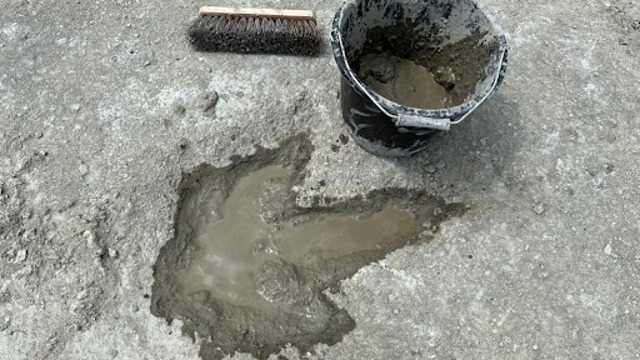
A dinosaur footprint discovered at Dewars Farm Quarry in Oxfordshire, England, is part of a large network of tracks that made up a "dinosaur highway." This find, which includes five major trackways, offers a glimpse into the ancient paths dinosaurs once walked. AP Photo
A remarkable discovery has been made in southern England, where nearly 200 dinosaur tracks, some of which date back 166 million years, were uncovered in a limestone quarry. The discovery happened when a worker digging clay in the Dewars Farm Quarry, located in Oxfordshire, noticed unusual bumps in the ground. These bumps led researchers to uncover what is now being called a "dinosaur highway."
The discovery builds upon earlier paleontological work in the area and sheds new light on the Middle Jurassic period. The excavation team, which consisted of over 100 people, worked throughout June to uncover these ancient footprints. According to Kirsty Edgar, a professor of micropaleontology at the University of Birmingham, these footprints provide an incredible opportunity to study the movements and interactions of dinosaurs, as well as the tropical environment they lived in.
Among the tracks, four sets belong to giant herbivores known as sauropods, which are believed to have been Cetiosaurus. These dinosaurs could grow up to 60 feet in length. A fifth set of tracks belongs to a Megalosaurus, a carnivorous dinosaur that reached 9 meters in length. The Megalosaurus left behind distinctive triple-claw prints and was the first dinosaur to be scientifically named over 200 years ago. The tracks also show areas where herbivores and carnivores appear to have crossed paths, sparking questions about possible interactions between these two types of dinosaurs.
Emma Nicholls, a vertebrate paleontologist at the Oxford University Museum of Natural History, noted that despite studying Megalosaurus for centuries, new evidence of these animals is still being found. This discovery of ancient tracks proves that even well-studied dinosaurs can still offer new insights.
Nearly three decades ago, the discovery of 40 dinosaur footprints in a nearby limestone quarry made headlines as one of the most important finds in paleontological history. However, that area is now mostly inaccessible, and the photographic evidence is limited. In contrast, the new excavation has been extensively documented, with over 20,000 digital images taken and drones used to create 3-D models of the tracks. This wealth of data will help scientists study the size, movement, and speed of the dinosaurs that left the footprints.
Duncan Murdock, an earth scientist at the Oxford Museum, emphasized the excellent preservation of the tracks, noting that they show how the mud was deformed as the dinosaurs' feet sank into it. The surrounding fossils, including burrows, shells, and plants, provide even more context, helping to recreate the muddy lagoon environment the dinosaurs walked through.
This exciting find will be showcased in an exhibit at the Oxford Museum and will also be featured in an upcoming broadcast of the BBC's "Digging for Britain" program.















